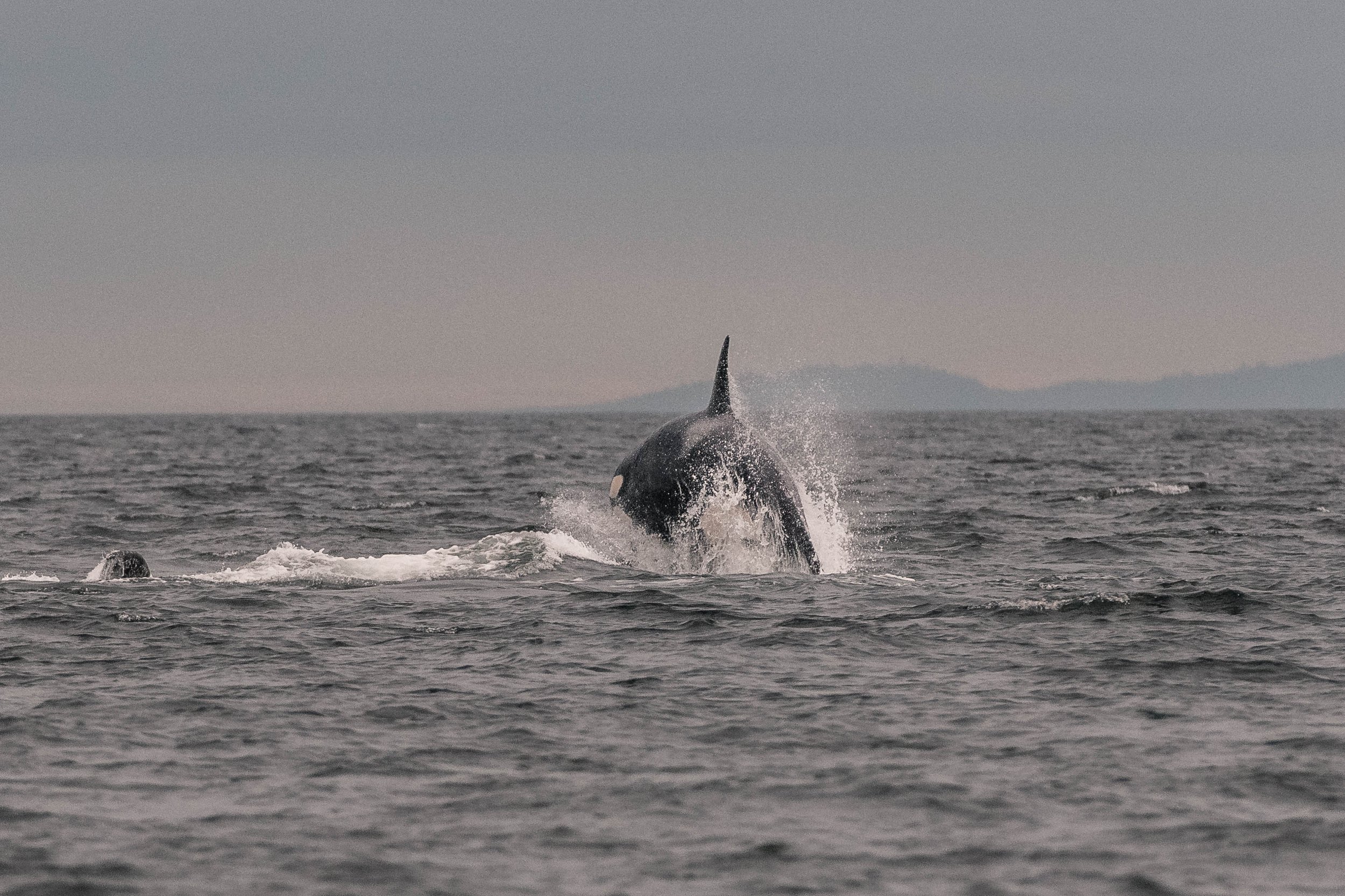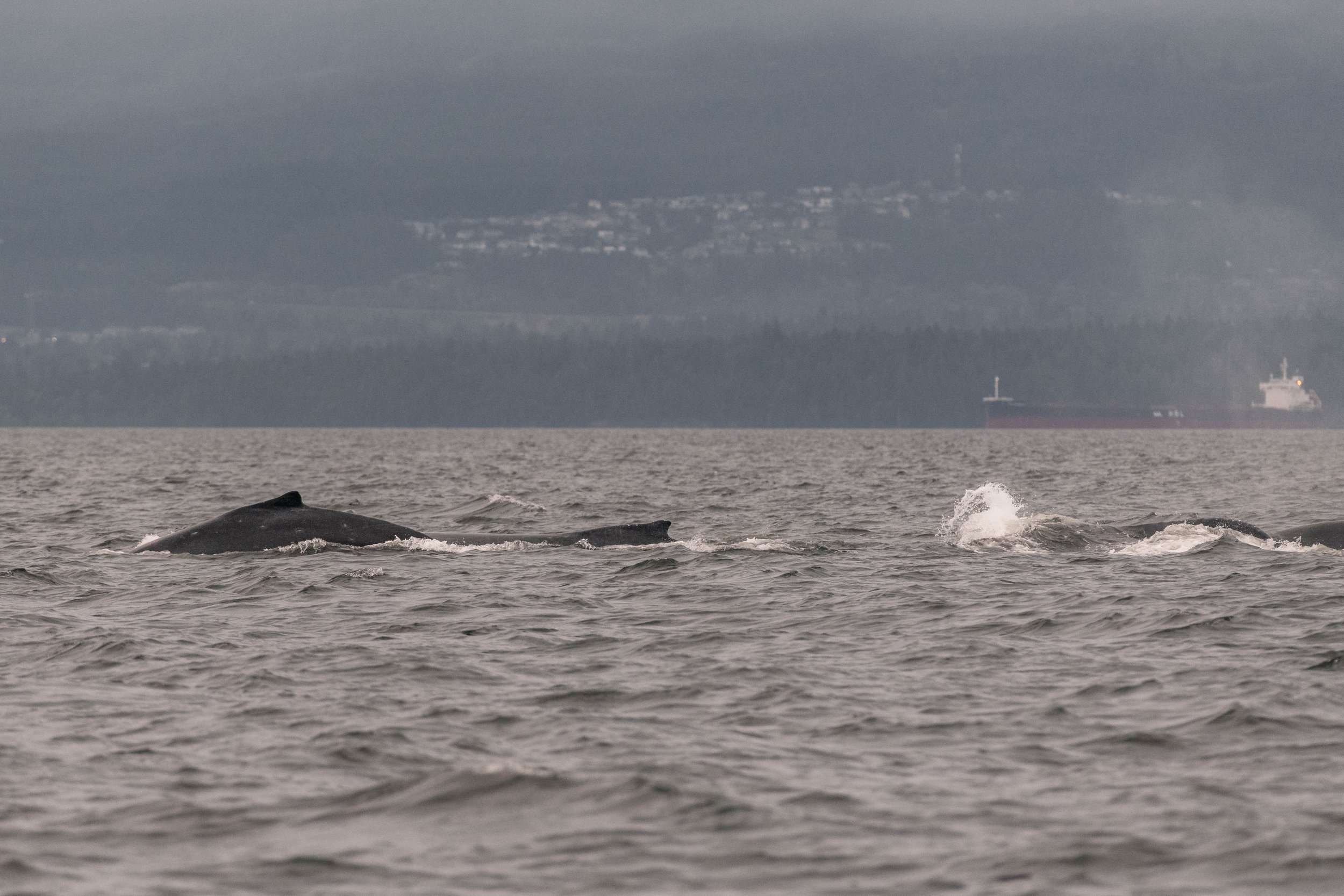June 27, 2025, 3:30 PM - Orca vs. Humpbacks: Who will win?!
Today was a wild and adventurous day! We headed out, our spirits high and eager to begin searching for whales. We began the search northbound, checking out the shoreline around North Nanaimo, Lantzville, and up towards Nanoose Bay. We scanned, looking for flukes and blows, and about half an hour after boarding, we spotted our first whales! We caught sight of a couple of blows, and then their signature flukes (tails) came up in the air as they began to dive. After snapping some photos, we identified at least 3 whales present: Kraken/Monarch/Pyramid (BCZ0180), Crevasse (BCX2054), and Chinook (BCY0996). These three were travelling slowly, occasionally diving, likely looking for a late lunch. At this time of year, our humpbacks are busily spending most of their waking hours eating to gain as much weight as possible. They will continue this daily routine for most of the summer to get their bodies prepared for the long and tiring migration back to their breeding grounds this winter.
Once we had enjoyed our time with these whales, we continued on our way, entering back into search mode. We cruised around the northern portion of our range, eyes always scanning for more blows, dorsals, or flukes. After adventuring around for a bit, we found another humpback - and this one was quite curious. When we got on scene, the whale ended up changing direction and started to come towards us. As it approached, we shut off our engines as per the whale watching regulations and waited to see what it would do. Suddenly, there was a nearby blow, and it was checking out our vessel! This behaviour is known as mugging - while it is not encouraged, it is a behaviour that can rarely be observed by curious individuals. Mugging can be extremely dangerous for the whale, as they could be injured if they approach a boat that isn’t aware of them. After giving our vessel a look over, the whale began to dive, and we were able to get a perfect ID shot of them. This little one was identified as Allusion (BCY1300), a whale that is known to our area, but we haven’t seen them as a company for several years. Shortly after Allusion continued on their way, and once they were a safe distance away, we continued onwards as well.
Once more, the search was on, our crew and guests eagerly searching. We turned south, continuing towards Gabriola Island, eyes peeled for any signs of movement or activity. This turned out to be the perfect place to check out, as we suddenly saw many black dorsal fins slicing through the water. We started counting and taking photos, and we concluded that we were with the T046Bs and the T123s, for a total of 12 orca present:
T046B Raksha ♀ (1988)
T046B2 Akela ♀ (2008)
T046B2B Takaya (2023)
T046B3 Sedna ♀ (2011)
T046B3A Munro (2025)
T046B4 Quiver ♀ (2013)
T046B6 Sol ♀ (2019)
T046B7 Tala (2023)
T123 Sidney ♀ (~1985)
T123A Stanley ♂ (2000)
T123C Lucky ♀ (2012)
T123D Darcy ♀ (2018)
The T046Bs have three calves amongst them under the age of 3 years old, which is a lot of hungry and excited babies to feed. Our Transient orca typically travel in pods of 6 to 7 members, so to see 8 of them (3 of them being youngsters ) all in one family unit is an incredible sight to behold. Raksha’s lineage has had a couple rocky moments over the years, with her fifth calf, T046B5, being the first documented case of infanticide in the orca species, and her grandchild T046B1B T’luk was believed to have passed away at a young age, potentially from complications with Chediak-Higashi Syndrome, a rare immunodeficiency disorder. While these sombre moments are a reminder of the fragility of life, seeing 3 calves amongst Raksha and her daughters is an uplifting reminder that life will persevere.
This wasn’t a normal and quiet orca encounter, though, as we suddenly saw a couple of huge backs amongst the smaller black dorsal fins - there were some humpbacks between the orca! Humpback and orca interactions are not common in our waters, so it is always incredibly exciting to document one of these moments. These interactions are interesting, as most people assume that the orca are the ones starting the 'fight’, but often the humpbacks are actually the ones charging on, trumpeting away as they race towards the orca!
Many people think humpbacks aren’t built to fight, mainly because they are baleen whales, so they don’t have teeth to bite. However, they have their own unique techniques and advantages that they can use in a brawl! Firstly, their sheer towering size is a huge advantage, as they are significantly larger than most other whale species. Our humpbacks also tend to have barnacles congregate and grow along the leading edge of their massive pectoral fins (side fins), resulting in a jagged and sharp edge that can be used defensively or offensively if needed. On top of that, with a huge amount of humpbacks feeding in a small area, they can also call out to others in case they need backup - it appeared that this may have happened today!
There were at least three humpbacks spotted rushing along amongst the orca. Chinook (one of our humpbacks from our earlier encounter) was spotted amongst the black and whites, along with a new face (or fin) that we identified as Fader (BCY0195). Two other humpbacks were also identified amongst the numerous orca - that being Neptune (BCY1021) and Hendrix (BCY1278) respectively. We had at least one other Unknown humpback present, but with all the action, we were only able to grab dorsal photos of them, and we have not yet confirmed their identity.
While we observed them, there were numerous breaches from the orca, as the bickering and fighting continued. It appeared that this little disagreement didn’t have a definitive answer, though, as both species ended up making their way away eventually once the excitement died down.
After an exhilarating time with our humpback and orca interaction, we sadly had to move along and start making our way back to Nanaimo. We had one last quick wildlife stop, though, where we saw a congregation of our Harbour Seals huddled together at the water’s edge. After a few minutes observing them, and a couple of birds hanging nearby as well, we made our way back towards the harbour, wrapping up an unforgettable trip!
Please enjoy these photos taken by Marine Naturalist Aly Kohlman!
Kraken’s fluke.
Crevasse’s fluke.
Chinook’s fluke.
Chinook’s dorsal fin while a friend dives beside them.
Allusion’s fluke.
Catching air!
T123 Sidney backdiving.
T123A Stanley behind T046B2 Akela and T046B Raksha.
Neptune’s fluke as they dive on their side.
Fader beside T123 Sidney - an intense moment!
T123D Darcy with a humpback in the background.
T123A Stanley with another whale flicking their tail beside them.
From left to right: one of the Unknown humpbacks, Neptune, and Fader.
Neptune and Fader.
T123D Darcy breaching in excitement.
A little baby belly as they breach!
Neptune, with a humpback swishing their tail behind them and one of the Unknowns ahead of them.
Hendrix’s fluke.
T123C Stanley trudging along.
T123D Darcy with T046B3 Sedna to her right (eyepatch) and another whale to her left.
T046B2 Akela with T123C Lucky behind her.
T123D Darcy with her face out of the water!
Fader’s fluke as they dive.
T123A Stanley.
An itchy River Otter on the docks.
A Double-creset Cormorant amongst a couple of Harbour Seals.


























